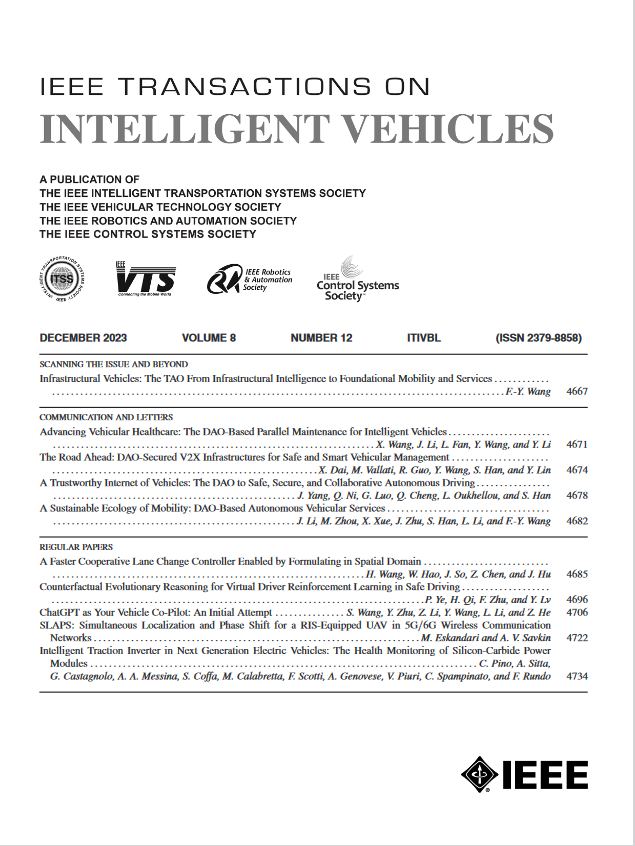Model-Free Safety Critical Model Predictive Control for Mobile Robot in Dynamic Environments
IF 14
1区 工程技术
Q1 COMPUTER SCIENCE, ARTIFICIAL INTELLIGENCE
引用次数: 0
Abstract
Within the context of Nonlinear Model Predictive Control (NMPC) design for autonomous mobile robots, which face challenges such as parametric uncertainty and measurement inaccuracies, focusing on dynamic modelling and parameter identification becomes crucial. This paper presents a novel safety-critical control framework for a mobile robot system that utilises NMPC with a prediction model derived entirely from noisy measurement data. The Sparse Identification of Nonlinear Dynamics (SINDY) is employed to predict the system's state under actuation effects. Meanwhile, the Control Barrier Function (CBF) is integrated into the NMPC as a safety-critical constraint, ensuring obstacle avoidance even when the robot's planned path is significantly distant from these obstacles. The closed-loop system demonstrates Input-to-State Stability (ISS) with respect to the prediction error of the learned model. The proposed framework undergoes exhaustive analysis in three stages, training, prediction, and control, across varying noise levels in the state data. Additionally, validation in Matlab and Gazebo illustrates that the NMPC-SINDY-CBF approach enables smooth, accurate, collision-free movement, even with measurement noise and short prediction times. Our findings, supported by tests conducted with the Husky A200 robot, confirm the approach's applicability in real-time scenarios.动态环境下移动机器人无模型安全临界模型预测控制
在自主移动机器人非线性模型预测控制(NMPC)设计的背景下,面临着参数不确定性和测量不准确性等挑战,关注动态建模和参数识别变得至关重要。本文提出了一种新的安全关键控制框架,用于移动机器人系统,该系统利用NMPC和完全来自噪声测量数据的预测模型。采用非线性动力学稀疏辨识法(SINDY)预测系统在驱动作用下的状态。同时,控制障碍函数(CBF)作为安全关键约束集成到NMPC中,即使机器人的规划路径与这些障碍物距离很远,也能确保避障。闭环系统对学习模型的预测误差证明了输入状态稳定性(ISS)。提出的框架在三个阶段进行了详尽的分析,即训练、预测和控制,跨越了状态数据中不同的噪声水平。此外,在Matlab和Gazebo中的验证表明,NMPC-SINDY-CBF方法即使具有测量噪声和较短的预测时间,也能实现平滑,准确,无碰撞的运动。我们的研究结果得到了赫斯基A200机器人测试的支持,证实了该方法在实时场景中的适用性。
本文章由计算机程序翻译,如有差异,请以英文原文为准。
求助全文
约1分钟内获得全文
求助全文
来源期刊

IEEE Transactions on Intelligent Vehicles
Mathematics-Control and Optimization
CiteScore
12.10
自引率
13.40%
发文量
177
期刊介绍:
The IEEE Transactions on Intelligent Vehicles (T-IV) is a premier platform for publishing peer-reviewed articles that present innovative research concepts, application results, significant theoretical findings, and application case studies in the field of intelligent vehicles. With a particular emphasis on automated vehicles within roadway environments, T-IV aims to raise awareness of pressing research and application challenges.
Our focus is on providing critical information to the intelligent vehicle community, serving as a dissemination vehicle for IEEE ITS Society members and others interested in learning about the state-of-the-art developments and progress in research and applications related to intelligent vehicles. Join us in advancing knowledge and innovation in this dynamic field.
 求助内容:
求助内容: 应助结果提醒方式:
应助结果提醒方式:


